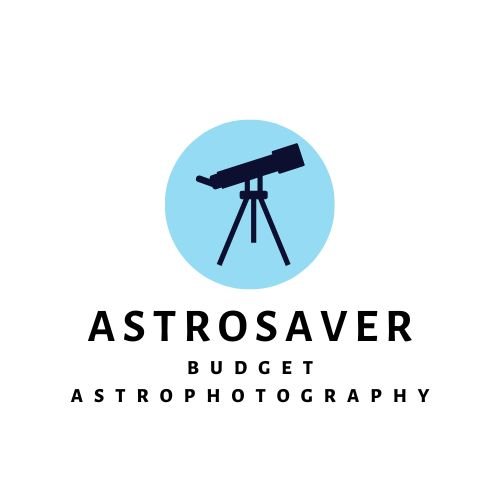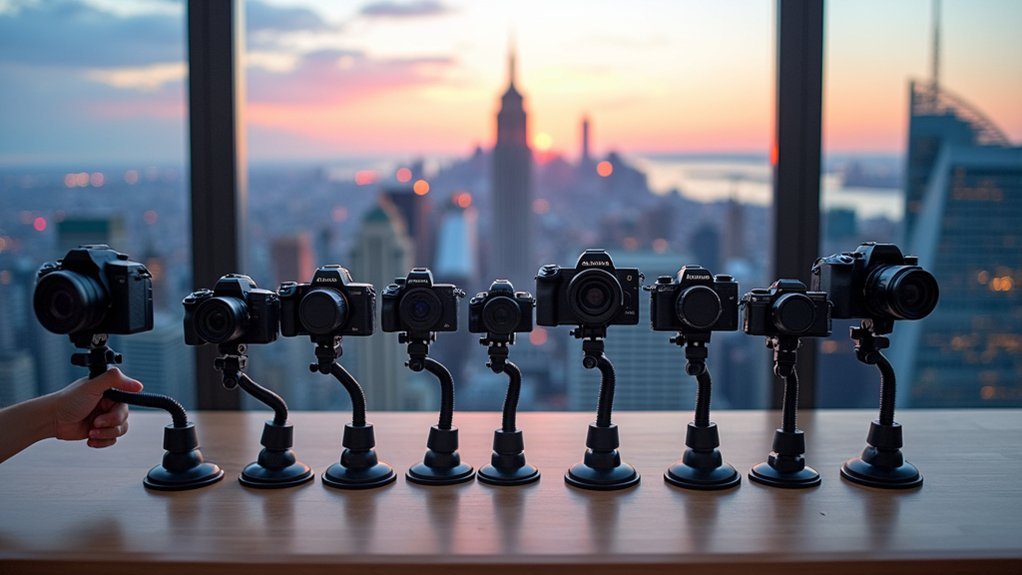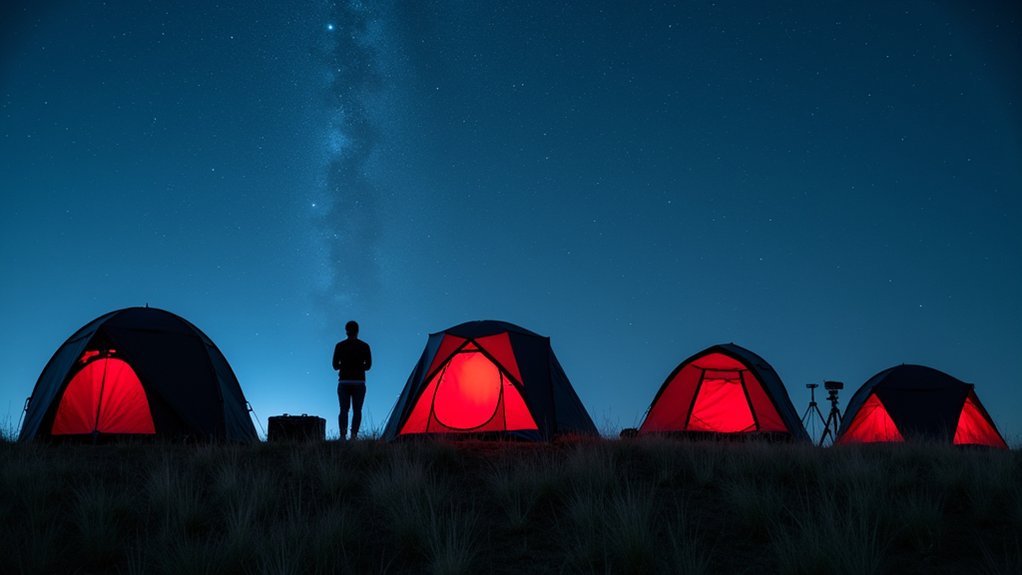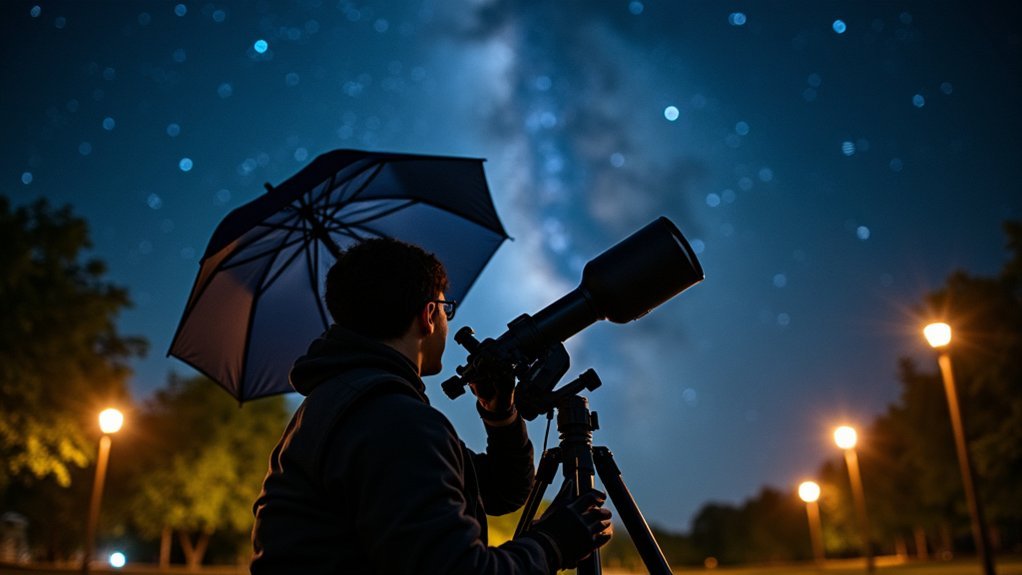Affordable focus lock options can drastically improve your astronomy experience by reducing focus shift from over 100 microns to under 40 microns. You’ll find DIY solutions like Velcro mounts and PVC pipe collars for under $20 that perform similarly to commercial options. Household items like rubber bands, foam pieces, and duct tape can serve as temporary fixes. Combine these with Bahtinov masks ($10-30) for precise initial focus. The stability difference will transform your celestial viewing results.
Affordable Focus Lock Options for Steady Astronomy Views

When your telescope’s focus drifts during an observation session, you’re likely missing out on essential celestial details. For Celestron SCT owners, focus locks offer a dramatic improvement in stability, reducing shift from 100-110 microns to just 30-40 microns on C11 models, and from 80-85 to 40-45 microns on C8 and C9.5 telescopes.
Installing a focus lock is straightforward—simply replace the standard focus knob and tighten the setscrews for immediate stability benefits.
While Optec focus locks provide continuous focus maintenance, they’re typically more expensive than alternatives.
Astrophotographers particularly benefit from these devices, reporting markedly improved imaging consistency.
If you’re seeking an affordable solution, consider pairing focus locks with software like FocusMax, which works with Maxim DL and various automation setups for reliable focusing performance.
Understanding Focus Shift in Amateur Telescopes
Although many amateur astronomers focus their telescopes once per session, several factors can cause your carefully adjusted focus to drift over time.
This focus shift is especially problematic in SCT telescopes, where temperature changes and physical movement can shift the primary mirror, resulting in a substantial focus change of 100-110 microns without proper stabilization.
When you’re capturing long-exposure astrophotography, even minor focus shifts can ruin your images by creating blurry, out-of-focus stars.
Installing a focus lock can dramatically improve your results—tests on C11 telescopes show focus shift reduction from 100+ microns to just 30-40 microns with a lock installed.
For best results, always check and secure your focuser after achieving precise focus, and choose a focus lock designed specifically for your telescope’s focus shaft ID.
DIY Focus Lock Solutions Under $20

You’ll find Velcro mounts among the simplest DIY focus lock options, requiring just adhesive-backed strips attached to both the focuser and telescope body to maintain position.
For a more rigid solution, PVC pipe sections can be cut and adapted to create a custom-fitting collar that prevents unwanted rotation of your focus knob.
These homemade approaches cost well under $20 and often perform as effectively as commercial options for casual astronomy sessions.
Simple Velcro Mount Designs
While commercial focus locks can cost upwards of $100, crafting your own Velcro-based solution offers remarkable effectiveness for a fraction of the price.
You’ll need just two strips of Velcro: attach one to your telescope’s focuser and the other to a stable base. This simple arrangement prevents unwanted movement during long exposure astrophotography.
What makes Velcro ideal among focusing tools is its versatility. When temperature changes demand adjustments, you can easily separate the strips, make your correction, and reattach them securely.
Most setups can be assembled for under $20 using materials from any hardware store. The design minimizes focus shift during imaging sessions, resulting in sharper, more detailed photos without the frustration of constantly refocusing your telescope throughout the night.
PVC Pipe Locking Mechanisms
Beyond Velcro systems, PVC pipe locking mechanisms represent another ingenious solution for astronomers seeking budget-friendly focus control. You can build these effective devices for under $20 using materials from any hardware store.
Create a custom focus lock by selecting PVC pipe with an inner diameter matching your telescope’s focus shaft. Add a simple tightening mechanism, and you’ll eliminate focus drift during imaging sessions.
| Component | Function | Approximate Cost |
|---|---|---|
| PVC Pipe | Main housing | $3-5 |
| Compression Fitting | Locking mechanism | $4-6 |
| Adjustment Knob | Easy operation | $2-3 |
| Mounting Hardware | Secure attachment | $3-5 |
These DIY solutions perform comparably to expensive commercial options while allowing customization with knobs or levers for easier adjustments. You’ll enjoy stable, crisp images without breaking your astronomy budget.
Budget-Friendly Bahtinov Masks for Precise Focusing
Achieving perfect focus remains one of the most challenging aspects of astrophotography, yet the humble Bahtinov mask offers an elegant, affordable solution to this common problem.
These simple devices create distinctive diffraction spikes around stars that visually indicate when you’ve reached ideal focus.
The ingenious pattern of diffraction spikes serves as a precise visual roadmap, guiding you straight to astronomical focusing perfection.
You’ll find Bahtinov masks priced between $10-$30, making them accessible for astronomers at any budget level. Many enthusiasts opt to create DIY versions customized to their telescope’s aperture, further reducing costs.
To use your Bahtinov mask, simply place it over your telescope’s aperture, point at a bright star, and adjust your focus until the diffraction pattern appears perfectly symmetrical.
When the central spike aligns precisely between the other two spikes, you’ve achieved perfect focus for crisp, detailed celestial images.
Temperature Compensation Techniques Without Breaking the Bank

You’ll find that implementing temperature compensation doesn’t require expensive equipment, with DIY thermal insulation wraps offering significant protection against focus drift during night temperature changes.
Passive acclimation methods, such as setting up your telescope an hour before imaging, allow components to reach thermal equilibrium and minimize focus shifts throughout your session.
Budget electronic controllers, like modified Arduino systems with temperature sensors, can provide automated focus adjustments at a fraction of the cost of commercial systems.
DIY Thermal Insulation Wraps
While commercial temperature control systems can cost hundreds of dollars, DIY thermal insulation wraps offer an incredibly affordable solution to combat focus drift in your telescope.
Using materials like reflective bubble wrap or foam insulation, you can create a protective barrier that minimizes thermal expansion effects on your optical components for under $20.
These simple wraps maintain temperature stability throughout your imaging session, eliminating the frustration of constant refocusing as the night progresses.
The key is proper application—ensure your wrap covers the optical tube without blocking necessary ventilation points. This balance helps your telescope maintain consistent temperature without overheating.
You’ll notice immediate benefits in image sharpness and stability, particularly during those critical moments when temperatures drop rapidly after sunset.
Your stars will stay pinpoint-sharp without constant adjustment.
Passive Acclimation Methods
Before investing in expensive electronic focus systems, consider that passive acclimation methods might solve your focusing woes for virtually no cost.
By allowing your telescope to gradually reach ambient temperature, you’ll minimize focus shifts caused by thermal expansion and contraction.
Start implementing these temperature stabilization techniques:
- Allow your equipment to cool down for at least 30 minutes before beginning observation.
- Cover your telescope with insulated blankets during temperature fluctuations.
- Monitor temperature changes with a simple thermometer to anticipate when manual focus adjustments may be needed.
- Check focus regularly throughout your session, especially after notable temperature drops.
These simple approaches can dramatically reduce focus drift, with some SCT users reporting shifts as low as 30-40 microns when properly acclimated with a basic focus lock.
Budget Electronic Controllers
Three affordable electronic solutions exist for amateur astronomers struggling with focus drift during night sessions. Budget electronic controllers offer effective temperature compensation without emptying your wallet.
The simplest option pairs temperature sensors with motorized focusers like the ZWO EAF, enabling real-time adjustments as temperatures drop throughout the night.
For the technically inclined, Arduino-based DIY solutions provide customizable and cost-effective focus control. These microcontrollers can be programmed to monitor temperature changes and make precise focusing adjustments automatically.
The key to success with these systems isn’t spending more money, but rather proper calibration and setup.
Many astrophotographers report excellent results using these affordable options, proving that maintaining sharp focus during temperature fluctuations doesn’t require premium-priced equipment—just smart implementation of feedback-driven focusing technology.
Repurposing Household Items as Temporary Focus Locks

Although commercial focus locks provide reliability, you can easily create effective temporary solutions using items already in your home.
These DIY approaches help maintain precise focusing during critical observation moments without requiring special tools or permanent modifications to your telescope.
Try these simple household alternatives:
- Wrap rubber bands or hair ties around the focus knob to create sufficient friction without completely restricting movement.
- Insert a small piece of foam between the knob and telescope body to prevent unwanted turning.
- Clip a clothespin onto the focus knob to apply constant pressure that maintains position.
- Fashion a duct tape strap around the knob and secure it to the telescope body.
These improvised solutions work surprisingly well for casual stargazing and can save you money while keeping your views steady and clear.
Essential Hand Tools for SCT Focus Adjustments
You’ll need precision Allen wrenches that match your SCT’s specific setscrew sizes to properly install and adjust focus locks without damaging delicate components.
Quality socket sets offer versatility when working with various locking screws and can help you achieve the perfect tension needed for stability during imaging sessions.
Having these tools readily accessible in your astronomy kit will save you frustration on clear nights when temperature changes require quick focus adjustments to maintain image sharpness.
Precision Wrenches Matter
A well-chosen precision wrench can make the difference between a frustrating night of slipping focus and hours of crisp astronomical viewing.
When adjusting your SCT telescope’s focus lock, you’ll need precision wrenches that fit the specific dimensions of your Celestron model’s screws.
These specialized tools help you:
- Apply the exact torque needed without damaging delicate components
- Prevent stripping of focus lock screws during adjustments
- Achieve the perfect balance between stability and adjustability
- Extend your telescope’s lifespan through proper maintenance
Using precision wrenches guarantees your focus stays locked during long imaging sessions while allowing quick adjustments when needed.
You’ll find that investing in the right set pays dividends in image quality and reduces wear on your valuable equipment.
Socket Sets for Adjustments
Three core socket sizes form the foundation of any amateur astronomer’s SCT adjustment toolkit. You’ll need the right socket set to make precise focus knob adjustments while minimizing image shift during your astrophotography sessions. The correct socket size prevents screw stripping and guarantees a secure fit when adjusting your telescope’s focus lock mechanism.
| Socket Size | Compatible Models | Application |
|---|---|---|
| 13mm | Celestron C8 | Focus shaft |
| 19mm | Older C11 models | Focus knobs |
| Varied | Multiple SCTs | Lock screws |
| 1/4″ drive | Most SCTs | Fine tuning |
| Hex | Modern SCTs | Set screws |
Choose socket sets made from chrome vanadium steel for durability. With proper maintenance—regular cleaning and proper storage—your socket set will serve you reliably for years, making it an affordable investment for steady astronomical viewing.
Software Alternatives to Expensive Autofocus Systems

While dedicated autofocus hardware can cost hundreds of dollars, several software alternatives offer comparable functionality at more accessible price points. Instead of investing in costly equipment, you can leverage these budget-friendly options to achieve precise focus for your astronomy imaging.
Consider these affordable autofocus solutions:
- NINA – A completely free platform with thorough mount/camera control, though proper configuration is needed to avoid occasional freezing.
- Astroart 7 – Features ASCOM compatibility with a free demo to test before purchasing.
- Voyager – A full-featured acquisition suite with advanced multi-mode autofocus capabilities.
- @focus3 – For SkyX Pro users, provides reliable and repeatable autofocus without additional cost.
FocusMax offers powerful functionality but requires Maxim DL integration, making it less accessible for those without existing software investments.
Simple Mechanical Solutions for Refractor Telescopes
Refractor owners facing focus drift issues can implement straightforward mechanical solutions without breaking the bank.
Mechanical focus locks replace your standard focus knob and securely hold the focusing ring in place after you’ve achieved perfect focus, greatly reducing unwanted shifts during imaging sessions.
These affordable devices are designed for specific refractor models, ensuring proper fit with your telescope’s focus shaft dimensions. Installation typically takes minutes with basic tools—simply remove the existing knob and attach the lock mechanism.
For best results, combine your new focus lock with a Bahtinov mask to achieve precise initial focus.
The performance improvement is measurable—some users report focus drift reduction from 100+ microns to under 40 microns. This dramatic stability improvement makes these simple mechanical solutions invaluable for serious astrophotography without expensive autofocus systems.
The Impact of Proper Collimation on Focus Stability
Achieving stable focus through mechanical locks only tells half the story, as proper collimation forms the critical foundation for any focus stability strategy.
When your telescope’s optical components are perfectly aligned, you’ll greatly reduce focus shifts that plague poorly adjusted instruments.
Studies show that proper collimation can decrease focus deviations from over 100 microns to just 30-40 microns when combined with focus locks, particularly in Schmidt-Cassegrain telescopes.
To maintain ideal focus stability:
- Check collimation before every imaging session
- Recheck if temperatures fluctuate considerably during the night
- Perform more frequent adjustments during seasonal changes
- Document your collimation settings for quick reference
Remember that even the best focus lock can’t compensate for misaligned optics.
Your astrophotography results depend first on properly collimated components capturing and directing light accurately through your optical train.
Low-Cost Digital Focusing Aids for Visual Observers
Although premium focus systems deliver outstanding precision, visual observers can achieve remarkable results with affordable digital focusing aids. The Bahtinov Mask creates three fine spike lines that intersect perfectly when your target is in focus, making it an excellent starter tool.
For more advanced options, consider the SharpStar2 filter, compatible with popular square filter systems. Its laser-etched pattern generates diffraction spikes that simplify precise adjustments.
The Focus on Stars filter offers clearer patterns for wide-angle lenses, though at a higher price point.
If you’re into digital imaging, FocusMax provides reliable autofocus capabilities for $150, though it requires Maxim DL to operate.
For consistent results throughout your observing session, implement temperature compensation methods to maintain focus stability.
Weather-Resistant Focus Lock Methods for Outdoor Viewing
Many astronomers struggle with maintaining precise focus during outdoor sessions as temperature changes and mechanical vibrations can disrupt your carefully calibrated settings.
Weather-resistant focus lock solutions, especially those designed for Celestron SCTs, can dramatically improve stability—reducing focus shifts from 100-110 microns to just 30-40 microns.
Before purchasing a focus lock system, consider these essential steps:
- Measure your telescope’s focus shaft dimensions to guarantee compatibility
- Replace your standard focuser knob with a more durable design
- Pair with Borg focusers for enhanced fine adjustment capabilities
- Properly tighten setscrews without excessive force
Installation requires careful attention, but the payoff is significant: consistent focus regardless of weather conditions.
For astrophotography enthusiasts, these systems also minimize image shift problems, allowing you to capture clearer, more detailed images of celestial objects.
Frequently Asked Questions
What Is the Best Focus Mode for Astrophotography?
For astrophotography, you’ll get the best focus using a Bahtinov mask on bright stars. Manual focusing in Live View works well, but automated systems like ZWO EAF with temperature compensation prevent focus drift during long sessions.
How Do You Lock the Focus in Photography?
To lock focus in photography, you’ll first focus on your subject, then engage your camera’s AF-lock button or switch the focus mode to manual after autofocusing. Some lenses have dedicated focus-lock switches.
How to Get Focus for Astrophotography?
To get focus for astrophotography, use Live View to magnify the brightest star, employ a Bahtinov Mask for precise alignment, and check focus regularly as temperature changes. You’ll want automated focusing tools for long sessions.
How Do You Focus an Astronomical Telescope?
You’ll focus an astronomical telescope by disabling autofocus, setting the lens to infinity, pointing at a bright star, using Live View to magnify the image, and adjusting until three distinct diffraction spikes appear.
In Summary
You’ll find that focus stability doesn’t require expensive equipment—just creative solutions and attention to detail. Whether you’ve chosen a simple DIY clamp, a homemade Bahtinov mask, or basic temperature compensation methods, you’re now equipped to maintain crisp views throughout your observing sessions. By implementing these affordable focus lock techniques, you’ll spend less time adjusting and more time enjoying the wonders of the night sky.





Leave a Reply